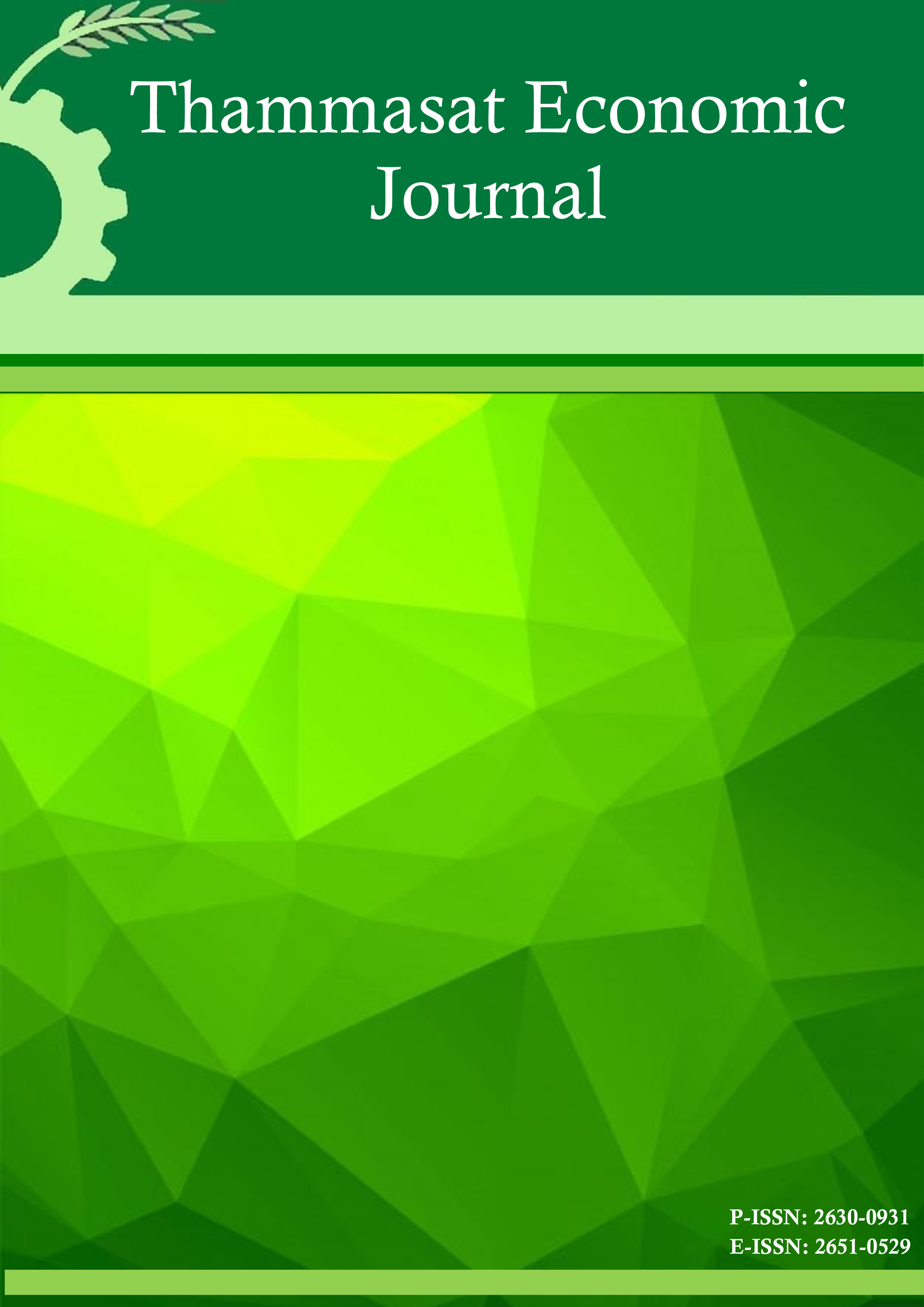MNEs and the Global Integration of the Thai Clothing Industry
Policy Implications for SME Development
Abstract
This paper aims to examine the export success of the Thai clothing industry with a view to formulating prudential policy for SME development. The key hypothesis concerns the contribution of MNEs. The methodology involves firm interviews, using ‘purposive sampling techniques in which contributors are chosen from information-rich cases for in-depth analysis related to the central issues under study. The key finding is that MNEs have played a pivotal role in the export success of Thai clothing industry through MNE buyer modes. Nevertheless, there are a number of small and medium clothing firms entered the clothing industry in the presence of the policy-induced incentives of the cascading tariff structure. These incentives are drying up as wage rates in Thailand continue to grow and there is the prevailing import threat of cheaper clothing from neighbours and China, in particular. This leads to the necessity of structural adjustment as a consequence of resource misallocation. Appropriate policy actions are needed to cushion costs incurred from the structural adjustment.
References
2. Bernard, A., J. Eaton, J.B. Jensen and S. Kortum (2003), ' Plants and Productivity in International Trade', American Economic Review, 93, p. 1268-90.
3. Berry, A. and B. Levy (1999), ‘Technical, Marketing and Financial Support for Indonesia’s Small and Medium Industrial Exporters’, in B. Levy, A. Berry and J.B. Nugent (eds.), Fulfilling the Export Potential of Small and Medium Firms, Dordrecht, Kluwer Academic Publishers.
4. Bird, K. (1999), ‘Industrial Concentration and Competition in ndonesian Manufacturing’, unpublished PhD thesis, Australian National University, Canberra.
5. Blomström, M. and A. Kokko (1998), ‘Multinational Corporations and Spillovers’, Journal of Economic Surveys, Vol.12, pp.247–277.
6. Borensztein, E., J.D. Gregorio, and J.W. Lee (1998), ‘How does Foreign Direct Investment Affect Economic Growth?’, Journal of International Economics, Vol.45, No.1, pp.115–135.
7. Borensztein, E., J.D. Gregorio, and J.W. Lee (1998), ‘How does Foreign Direct Investment Affect Economic Growth?’, Journal of International Economics, Vol.45, No.1, pp.115–135.
8. Clerides, S., S. Lach and J. Tybout (1998), 'Is Learning by Exporting Important? Micro-dynamic Evidence from Columbia, Mexico and Morrocco’, Quarterly Journal of Economics, 113, p.903-948.
9. Cole, W. (1998), ‘Bali’s Garment Export Industry’, in H. Hill and K.W. Three (eds), Indonesia’s Technological Change, Singapore, Institute of Southeast Asian Studies
10. Görg, H. and D. Greenaway (2001), ‘Foreign Direct Investment and Intra-Industry Spillovers: A Review of the Literature’, Research Paper Series No.37, Leverhulme Centre for Research on Globalization and Economic Policy, London.
11. Harvie, C. and Lee, B.C. (2002), ‘East Asian SMEs: Contemporary Issues and Developments-An Overview’, in C.Harvie and B.C. Lee (eds), The Role of SMEs in National Economies in East Asia, Cheltenham, Edward Elgar.
12. Hill, H. (2001), ‘Old Policy Challenges for a New Administration: SMEs in Indonesia’, Asian Survey, 41(2) p. 248-270.
13. Hobday, M. (1995), Innovation in East Asia: The Challenge to Japan, Edward Elgar, Vermont. Hone, A. (1974), ‘Multinational Corporations and Multinational Buying Groups: their Impact on the Growth of Asia's Exports of Manufactures-Myths and Realities’, World Development, Vol.2, No.2, pp.145–149.
14. Jongwanich, J. (2008), ‘Real exchange rate overvaluation and currency crisis: evidence from Thailand’, Applied Economics, 40(3), 373-82
15. Jongwanich, J. and A. Kohpaiboon (2007), ‘Determinants of Protection in Thai Manufacturing’, Economic Papers, 26(3), 276-94.
16. Kohpaiboon, A. (1995), ‘Policy Distortion and Competitiveness of Thai Textile Industry, Master Thesis, Faculty of Economics, Thammasat University.
17. Kohpaiboon, A. (2006), Multinational Enterprises and Industrial Transformation: Evidence from Thailand, Edward Elgar, Cheltenham.
18. Kohpaiboon, A. (forthcoming), ‘MNEs and Global Integration of Thai Processed Food Industry: A Firm Level Study’, Asian Journal of Agriculture and Development.
19. Keesing, D.B. and S. Lall (1992), ‘Marketing of Manufactured Exports from Developing Countries: Learning Sequences and Public Support’, in G.K. Helleiner (ed.), Trade Policy, Industrialization and Development: New Perspectives, Clarendon Press, Oxford.
20. Kessing, D.B. (1983), ‘Linking Up to Distant Markets: South to North Exports of Manufactured Consumer Goods’, American Economic Reviews, Vol.73, No.2, pp.338–342.
21. Lipsey, Robert E. (2000), ‘Inward FDI and Economic Growth in Developing Countries’, Transnational Corporations, Vol.9, No.1, pp.67–95.
22. Melitz, M. (2003), ‘The Impact of Trade on Intra-industry Reallocations and Aggregate Industry Productivity’, Econometrica, 71, p. 1695-1725.
23. Nabeshima, K. (2004), ‘Technology Transfer in East Asia: A Survey’, in S. Yusuf, M. A. Altaf, K. Nabeshima (eds.), Global Production Networking and Technological Change in East Asia, Oxford University Press, Washington D.C.
24. Nayyar, D. (1978), ‘Transnational Corporations and Manufactured Exports from Poor Countries’, Economic Journal, Vol.88, No.349, pp.59–84.
25. Oman, C. (1984), New Forms of International Investment in Developing Countries, Development Centre of the Organisation for Economic Co-operation and Development, Paris.
26. Oman, C. (1988), ‘Cooperative Strategies in Developing Countries: The New Forms of Investment’, in F.J. Contractor and P. Lorange (eds.), Cooperative Strategies in International Business, Lexington Book, Massachusetts.
27. Patton, M. Q. (1990), Qualitative Evaluation and Research Methods (2nd edition), Sage Publications, California.
28. Ramstetter, E. (2006), ‘Are Productivity Differentials Important in Thai Manufacturing’ in Ramstetter, E. and F. Sjoholm (eds.), Multinational Corporations in Indonesia and Thailand: Wages, Productivity and Exports, New York, Palgrave Macmillan, p. 114-142.
29. Rhee, Y.W., B. R. Larrson, and G. Pursell (1984), Korea's Competitive Edge: Managing the Entry into World Markets, John Hopkins University Press, Baltimore.
30. Richardson, G.B. (1972), ‘The Organization of Industry’, Economic Journal, Vol.82, No.327, pp.883–896.
31. Rock, M. and D.P. Angel (2005), Industrial Transformation in the Developing World,, Oxford University Press, Oxford.
32. Schiller, J. and B. Martin-Schiller (1997), ‘Market, Culture and State in the Emergence of an Indonesia Export Furniture Industry’, Journal of Asian Business, 13(1), p. 1-23.
33. Sjöholm, F. (1997), ‘R&D, ‘International Spillovers and Productivity Growth’, Lund Economics Studies No.63, Lund University, Lund.
34. Suphachalasai, S. (1994), ‘Thailand’s Clothing and Textile Exports’, ISEAS Occasional Paper, No. 89, Institute of Southeast Asian Studies, Singapore.
35. Vernon, R. (2000), In The Hurricane’s Eye: The Troubled Prospects of Multinational Enterprises, MIT Press, Cambridge.
36. Wagner, J. (2007), 'Exports and Productivity: A Survey of the Evidence from Firm Level Data', World Economy, 30, p. 60-82.










